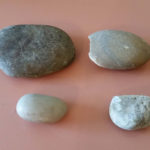- Series:History, Transcript English
Psalm 104:6
“Thou coveredst it with the deep as with a garment: the waters stood above the mountains.”
 In one Laurel and Hardy movie, Stan Laurel answers a telephone, says, “It sure is”, and replaces the receiver. When Ollie asks what it was, Stan says it was a joke call. “The man just said, ‘It’s a long distance from Atlanta, Georgia’, and I said ‘It sure is’”.
In one Laurel and Hardy movie, Stan Laurel answers a telephone, says, “It sure is”, and replaces the receiver. When Ollie asks what it was, Stan says it was a joke call. “The man just said, ‘It’s a long distance from Atlanta, Georgia’, and I said ‘It sure is’”.
I have mentioned the Troutdale Formation before, relating how huge masses of stones were transported by large amounts of water under pressure. This forced the enormous quantity of stones to be rounded, but also left flattened, as they were gradually pressured into approximate horizontal rows.
What we didn’t discuss at that time was that 20% of these stones are quartzites. Yet, there is no source of quartzite close to these deposits. The nearest quartzite sources are in the Rocky Mountains, so these stones must have been transported from the Rockies, about 300-600 miles away. Clearly, any supposed early version of the Sandy River could not have had the length or energy to transport stones so far. Besides which, the local topography shows Sandy River cutting through features laid down after the Troutdale Formation, indicating that this river did not exist to transport the quartzite. Moreover, quartzite is incredibly hard – nearly as hard as diamond. It can easily be transported over such distances without being ground into rounded flattened shapes, so the energy of the transporting must have been very great indeed.
The only explanation for the transporting of the quartzite that makes any sense is to assume a vast, worldwide Flood, as recorded in Genesis. Without such high energy water, the Troutdale Formation would not have happened. Author: Paul F. Taylor
Prayer: Thank You, Lord, that Your word speaks true. So many puzzles fall into place when we start by assuming Your word to be true. Amen.
Ref: Hergenrather, J., Noah’s Long-Distance Travelers, Creation 28(3):30–32—June 2006. Image: Quartzite, and other Troutdale stones, photographed by author.
193 18
